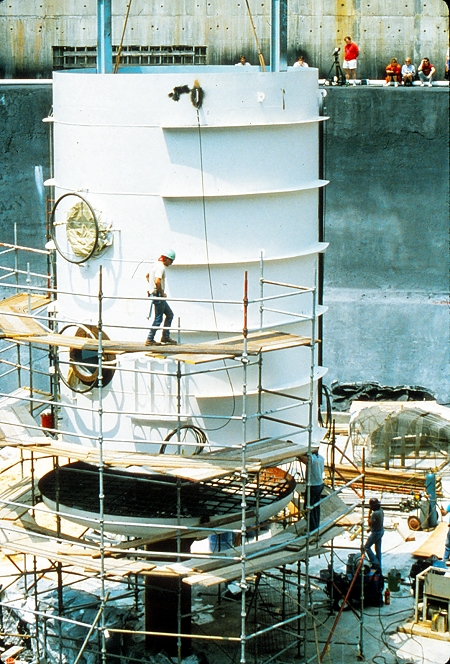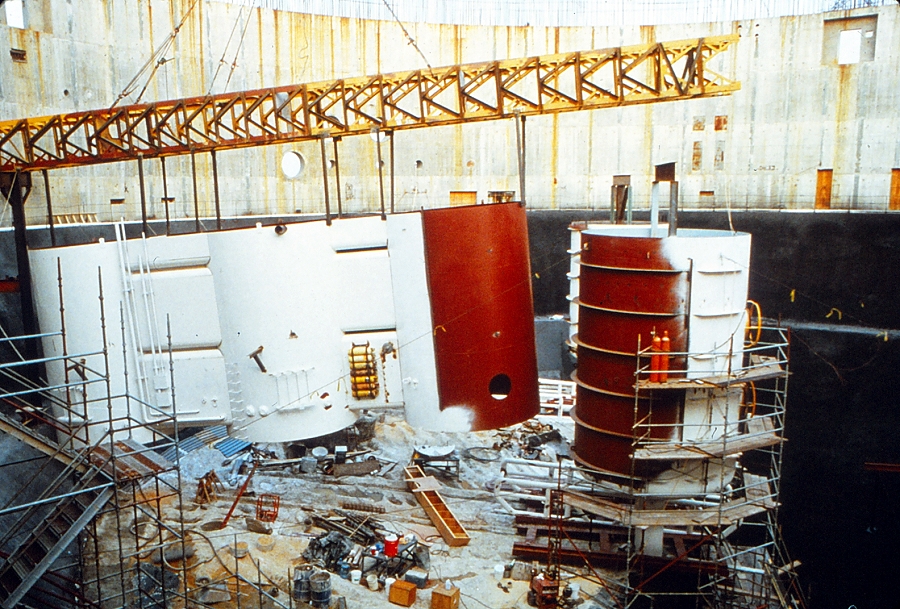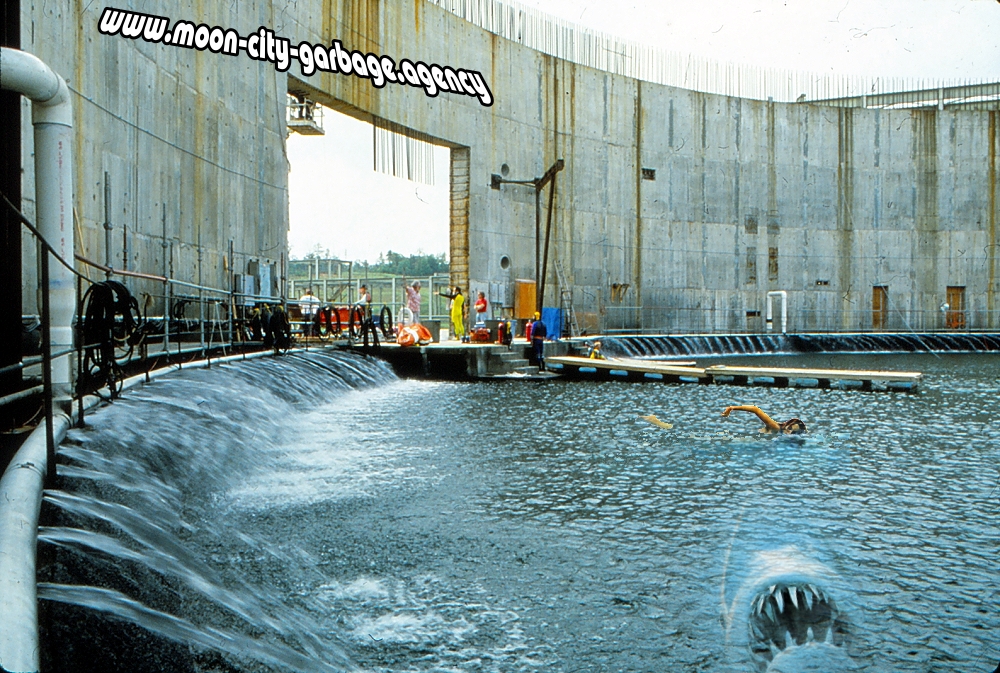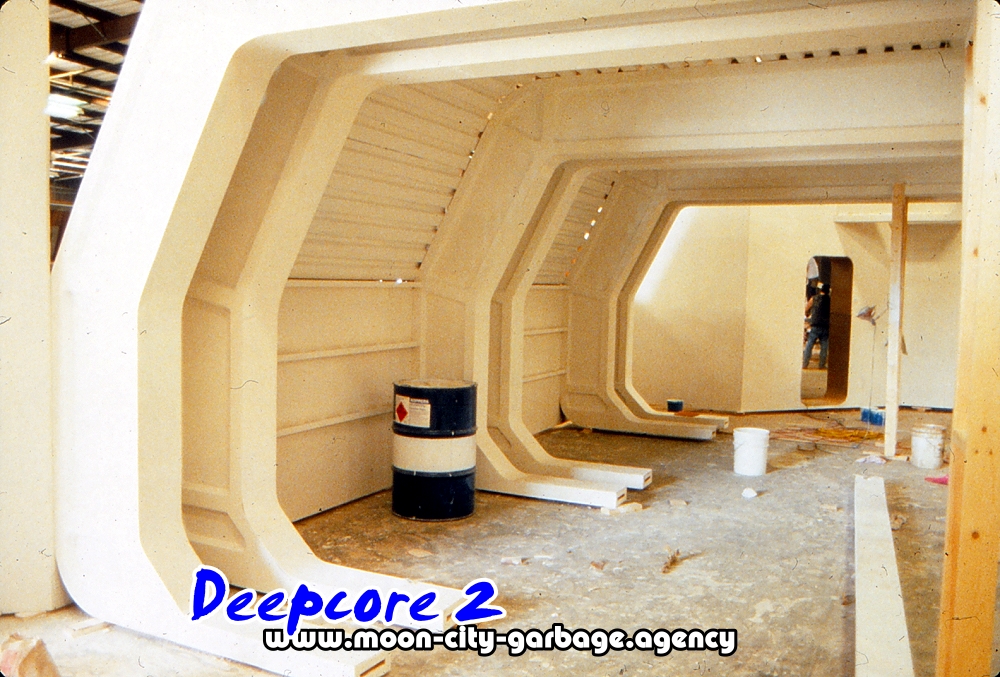|
Deepcore 2 - Set Design and Construction |
|||||
|
|
|||||
|
|
|||||
|
The Abyss - A technological adventure extraordinaire by James Cameron. |
|||||

|

|
||||
|
Director James Cameron has assembled an incredible crew of nine visual effects units for
his challenging epic (Dream Quest, ILM,...). The famous conceptual and production designer Ron Cobb ('Star Wars','Indiana Jones','Aliens',...) was there for the styling of the entire thriller. He designed, amongst various other things, the underwater oil drilling habitat 'Deepcore 2'. |
|||||

|
|||||
|
Since a substantial part of the movie will be shot under water, Cameron essentially needed a pool. The deepwater tank on Malta could be used for underwater photography, but it is filled with unfiltered saltwater and unheated. For the lengthy shootings under water you need warm water. Well, a rather unusual option turned up by surprise. James Cameron found his gigantic water tank, a semi-finished Reactor Containment Building, on the site of an uncompleted Duke Power Company Nuclear Power Plant near the small town of Gaffney (South Carolina). 200 feet in diamater and 55 feet in depth. The whole Nuclear Power Plant was converted into a functioning studio. |
|||||

|
|||||
|
This dirty water hole, a half-finished concrete structure (turbine pit) of the former Nuclear Power Plant, will be converted into the FX Tank for the underwater effects unit to shoot the miniatures and other FX stuff. They will built the wet porch launch bay set hear. |
|||||

|
|||||
|
The colossal Reactor Containment Building will be the deepwater pool for the full scale section of the 'Deepcore 2' habitat set on the cliff next to the Cayman Trough. Oil drilling in a Nuclear Power Plant? |
|||||

|
|||||
|
Responsible for translating Ron Cobbs Deepcore designs into reality was the famous British production designer Leslie Dilley ('Star Wars','Indiana Jones',...) and a large set construction crew. The construction crew begins on the ground of the Reactor Containment building with the skeletal steel structure. This will be the cliff of the Cayman Trough and the foundation for the Deepcore set. |
|||||

|
|||||
|
The Cayman Trough Cliff. Each component, the steel beams, sheets, all tools, welding equipment, ... were brought into the building by crane. |
|||||

|
|||||
|
The Abyss - construction site. You can see fiberglass parts for the Cliff lying around, casts of real rocks. |
|||||

|
|||||
|
The work on the Cayman Trough goes on. Some first components for the Deepcore 2 platform were flown in ...by crane. The 'watering crew' is laying water pipes around the set to fill the pool. |
|||||

|

|

|
|||
|
The Deepcore 2 set is a well-organized pretty big construction site with various construction
columns and site managers. The conceptual design for a diving helmet by Ron Cobb. These hard hat diving helmets were specially manufactured for the production. They have a large viewing glass and allow direct voice communication and dialogue recording. |
|||||

|
|||||
| Larger 'Deepcore' components are pre-assembled outside of the Reactor Containment building. | |||||

|
|||||
| And this junkyard will be an underwater oil drilling platform in a few days? Respect! | |||||

|

|

|
|||
| The finished 'Deepcore 2' set will be a heavy monster of concrete, iron and steel. | |||||

|
|||||
| The Cayman Trough Cliff looks great. All work under great time pressure. | |||||

|
|||||
|
Director James Cameron and Producer Gale Anne Hurd during a tour around the set, showing the Deepcore location to the crew and some of the divers(?). |
|||||

|
|||||
|
Deepcore 2 - The Abyss. Just a section of the Deepcore 2 was built in full scale, but it still has enormous proportions. |
|||||

|
|||||
|
A powerful pumping system fills the colossal pool with up to seven million gallons of water from a nearby lake. It took several days to fill the tank. Every single liter of water was filtered, chlorinated and heated. What a hassle. |
|||||

|
|||||
|
To make up for time, the fillling of the pool is started early, before the painting crew finished the job. The last painting work was done from a raft. You can see it in the photo, moored at the Deepcore Set. |
|||||

|

|

|
|||
| Deepcore 2 in the deep sea, in the footsteps of Jacques Cousteau. What will they find? | |||||

|
|||||
| An aerial view of Deepcore 2 in the Nuclear Pool. | |||||

|
|||||
|
A great photo that allows us a glimpse of both tanks. The colossal pool with the Deepcore 2 Set and the turbine pit with the FX pool. |
|||||

|
|||||
|
The FX pool Studio. The pool was especially used for all kind of miniature shots and
other visual effects. Besides that, they shoot the scenes in the Deepcore 2 wet porch (moon pool) here. The wet porch set was built around and over the FX pool. Inside of Deepcore 2, the wet porch is giving access to the water below to launch the Flatbed, shown on the right. |
|||||

|
|||||
|
Director James Cameron (left) discusses the filming with the legendary underwater cinematographer Al Giddings (in water with cap) and a crew of divers. |
|||||

|
|||||
|
The pool is not deep enough to represent the total darkness of the ocean depths. In order to avoid outside light influences you had to darken the pool. A huge black tarpaulin was installed over the entire tank. |
|||||

|
|||||
|
Gone with the Wind. A big irreparable crack in the tarpaulin caused a shifting of the production to night time. All were thrilled! Grrr... |
|||||

|

|

|
|||
|
This looks strange. The guys dumping Dylite into the pool? Dylite is an Expanded Polystyrene material available for foam processing (plastic cups,..). Many such cartons of Dylite, filled with millions of tiny black plastic beads, were floated on the surface to block the light and all kinds of reflections and mirror images. You dive through a flabby layer of black plastic beads before you disappear into the dark depths. This is nothing for people with claustrophobia! |
|||||

|
|||||
|
Conceptual design of the Deepcore 2 wet porch launch bay by Steve Burg, 1988. A lockout chamber to launch and recover the Flatbed and other submersible vehicles. |
|||||

|
|||||
| The Deepcore 2 wet porch set construction - mainly of wood. | |||||

|
|||||
|
The wet porch set is not finished yet, but director James Cameron is doing some initial dives. Crystal clear water, as in the Caribbean. |
|||||

|
|||||
| The finished wet porch (moon pool) in the movie. The Flatbed is launched for a dive. | |||||

|
|||||
|
The Flatbed submersible was designed by Ron Cobb to support underwater oil drilling operations. It was piloted from the surface. The actor sitting inside was able to play with a couple of buttons but not much more. An unpleasant feeling to have no control. Flatbed has several functional components (a gripper,...). |
|||||

|
|||||
|
Flatbed concept art by Steve Burg. Steve was in the Ron Cobb team and worked on the miniature designs, the deep-sea Aliens and various conceptual designs for the show. Steve Burg on Ron Cobb:'...he was a de facto mentor to me.' |
|||||

|
|||||
|
Hope you enjoyed the little dive into the set construction of 'The Abyss'. A colorful report on the gloomy underwater photography and difficult illumination might follow. |
|||||
